Let’s discuss some of the Waves mastering plugins including EQs, compressors, tape emulations and more!
As an experienced music producer, I often find Waves plugins to be among my favorites, thanks to their high sound quality, innovative design, and industry-standard reliability. The brand has built a reputation as a go-to brand for musicians, audio engineers, as well as producers with their combination of cutting-edge technology and user-friendly interfaces, making them suitable both for beginners and seasoned professionals.
Through the years, Waves created a good collection of quality plugins from surgical EQs, vintage-inspired compressors, or tools that enhance width and depth. The collection has the versatility to offer whatever you need to take care of every aspect of mastering. What I really respect is the precision algorithms with minimal artifacts for sound shaping with top-notch accuracy without sacrificing the natural character of the mix. Also, the frequency updates are another fan favorite when it comes to Waves.
What can I tell? Beyond the technical side, I love how Waves inspires users to be creative with intuitive designs that encourage experimentation, from subtle enhancements to bold and dynamic results. With decades of experience in the audio industry, they continue to impress users with mixing and mastering tools for polished and professional-sounding tracks. So, today, we will be traveling to their world to see some of the best plugins Waves has in the collection. So, let’s start!
1. Abbey Road TG Mastering Chain
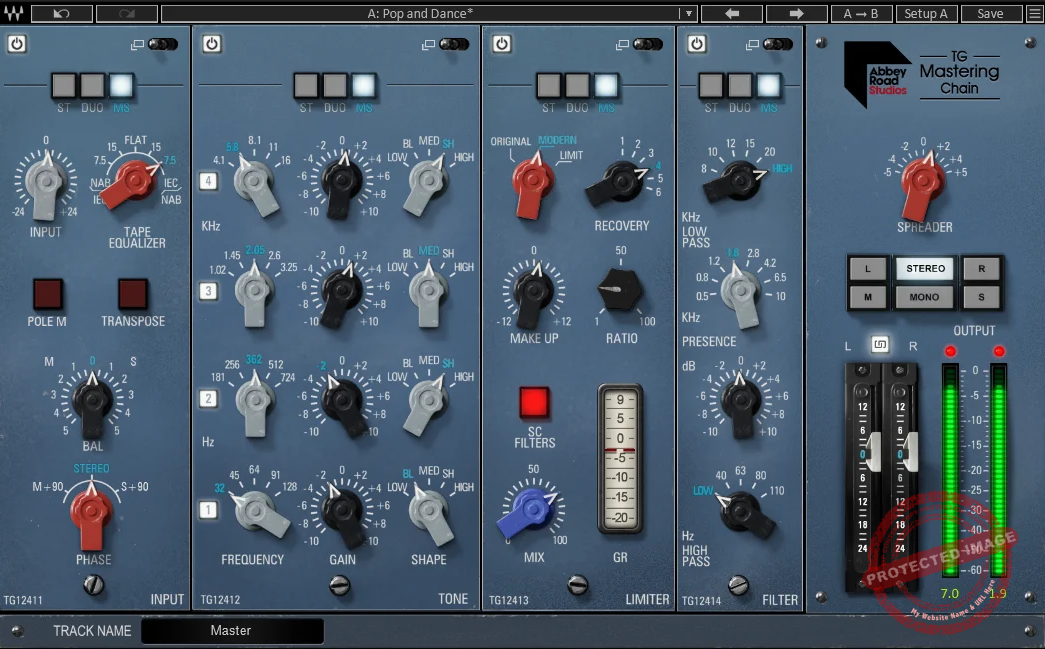
As a versatile plugin, Abbey Road TG Mastering Chain emulates the classic TG12410 Transfer Console used on legendary albums like Dark Side of the Moon. It features a modular design with 5 customizable processing stages, including Input, Tone (EQ), Limiter, Filter, and Output, each packed with advanced mastering and mixing features.
What sets this plugin apart from the other mastering chains is its versatility, as it has customizable module order, mid-side processing, and stereo-duo controls, making it a flexible powerhouse for mastering projects, mix buses, and individual tracks.
I love the Input module as it has some great features, such as the tape EQ, polarity adjustments, and the innovative Transpose function, which gives unique insights into stereo imaging by swapping left-right channels or mid-side signals.
In my opinion, the Tone module is another highlight cause it brings a 4-band EQ with fully selectable frequencies and filter types for high-precision tonal shaping. The Limiter offers some good features as well, such as multiple modes with Original, Modern, and Limit, as well as sidechain filters for characterful compression or transparent dynamic control.
The Filter module is standard with high and low pass filters along with the presence boost-cut addition, which is a smart addition for me. Finally, the Output module has stereo spread control and advanced monitoring options like mono, mid-only, and side-only playback.
I think this unit can be suitable for beginner producers, too, cause it comes with more than 100 quality presets. They are good points to start tweaking for polished mixes.
Just like many mastering chain plugins, a brick-wall limiter is the only lacking feature that stops this unit from being a one-stop solution. But, if you combine it with a good brick wall limiter, I think it can be an indispensable tool for achieving professional-quality mixes in your DAW.
Abbey Road TG Mastering Chain is available in VST3, AAX, and AU (Mac only) formats for macOS Monterey 12 or newer and Windows 10 or later.
2. SSL G-Master Buss Compressor
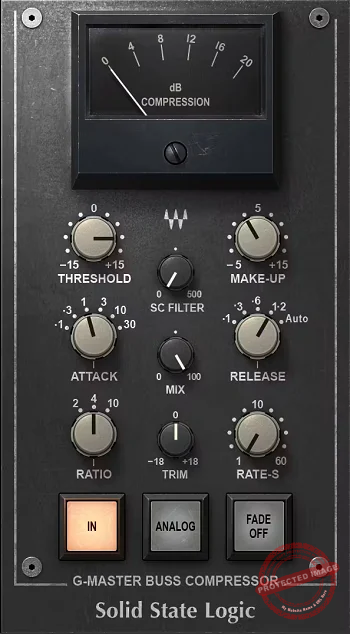
Praised for its ability to add that signature glue effect without giving away the energy and punch of a mix, the SSL G-Master Buss Compressor quickly became an industry standard for mix bus compression. It combines analog warmth with the ease of modern digital workflows to create cohesive and polished-sounding results effortlessly.
My favorite side of this compressor is its simplicity, without a doubt. With its intuitive analog-inspired interface and easy workflow, along with essential controls like Threshold, Ratio, Attack, Release, Makeup Gain, and even the sidechain and fade options, it gets you to the point without distractions. The plugin is not only tied to the original SSL with its sound but also with its controls and visuals.
The real standout feature for me here is the harmonic distortion toggle, introducing that subtle analog Noise and warmth to the mix. You can customize the amount of the effect to give different vibes to your mix.
When I use this plugin, I start slightly tweaking from a 30 ms attack and 0.3-second release, as this is the sweet spot for me to let transients breathe naturally while maintaining the tight dynamics. I go with a 4:1 ratio and 2-3 dB of gain reduction to allow the compressor to add clarity and cohesiveness to the mix without making the dynamics fully vanish.
Sometimes, I feel a bit more analog coloration would be good, but other times, I decide that the balance between transparency and character is what makes this unit so versatile to use with different projects.
I gotta admit that this is not only for mix buses, as I also use it with drum groups for cohesion and punch. I even tried it with vocal buses, and it provided a polished sound. I always aim for subtlety with this unit, as overusing it flattens the dynamics harshly and loses life in a mix.
In short, the SSL G-Master Buss Compressor is a reliable and powerful plugin to use for a fast and straightforward workflow, making it an essential tool for mix and mastering engineers.
G-Master Buss Compressor is available in VST3, AAX, and AU (Mac only) formats for macOS Monterey 12 or newer and Windows 10 or later.
3. Kramer Master Tape
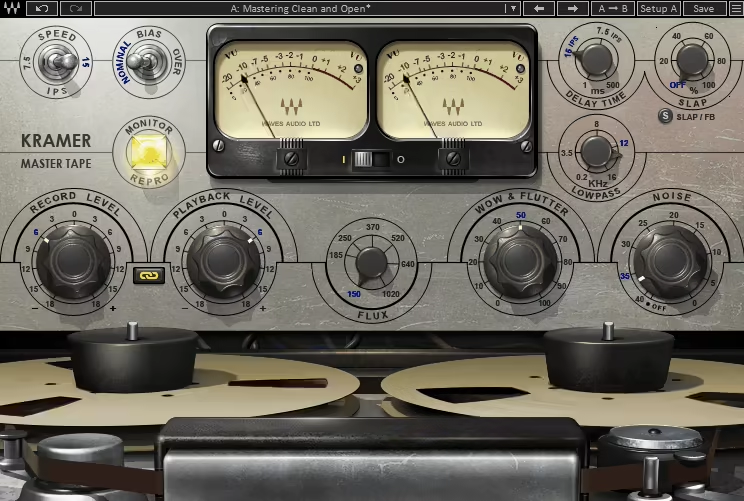
If you like the vintage warm tones with depth and character in your tracks, Waves has you covered with the Kramer Master Tape plugin, which is modeled after the rare Ampex 350 tape machine with 351 electronics recreating Kramer’s signature Olympic Studios sound. Developed in collaboration with the studio legend Eddie Kramer, it is a versatile unit for both full mixes and individual track processing.
The first thing I liked when I saw Kramer Master Tape was its GUI, as it is really well laid out with spinning tape reels and an organized range of controls. It has the Record and Playback levels to adjust the gain in the tape heads, while the usual suspect, Wow-Flutter, and Noise dials decide between the subtle tape color or intense lo-fi degradation.
I also loved the tape delay section as well cause it increases the creative potential with feedback, delay time, and a low-pass filter, which comes in handy if you like dub-inspired effects or simply add depth to your mixes.
I think the key features of the plugin are the Bias options (Nominal and Over), as they allow experimentation, as well as the Flux knob, which is important for controlling the gain capabilities of tape emulation as it evolves. In the end, you get a warm analog tone that enhances the drum, guitar, and vocal tracks, as well as mastering tasks by gluing mixes together.
There is not much to say against this saturation unit as it does what it promises and even goes a bit beyond that with the tape delay. It sounds good, easy to work with, and looks pretty. Maybe the price point can be a drawback, but as a Waves plugin, I don’t think it is overly priced.
I recommend this unit to producers who are after retro authenticity or a real analog charm in the digital world.
Kramer Master Tape is available in VST3, AAX, and AU (Mac only) formats for macOS Monterey 12 or newer and Windows 10 or later.
4. F6 Floating-Band Dynamic EQ
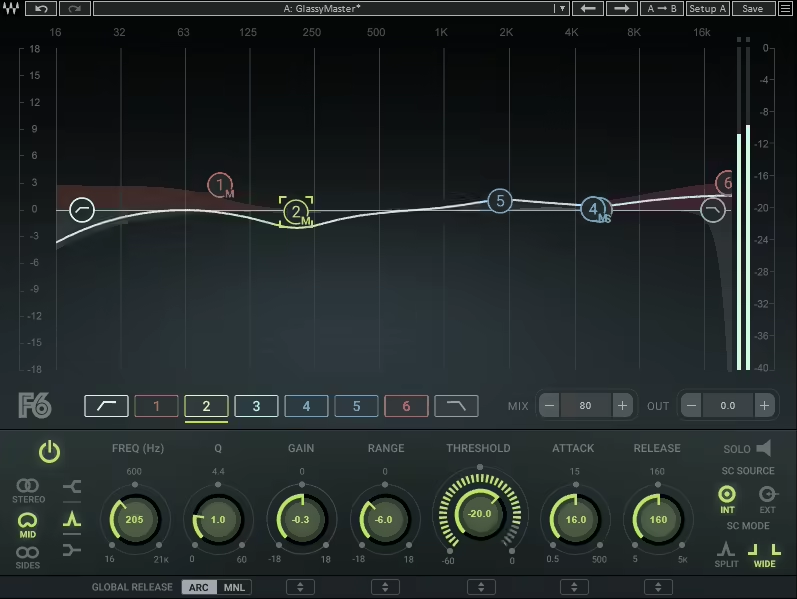
Well, if you are one of those who still use the default DAW EQ, this one is for you. Designed both for surgical precision and powerful tonal shaping, the F6 Floating-Band Dynamic EQ offers 6 fully adjustable bands in the frequency spectrum, including overlapping positions and high and low-pass filters on both ends, giving you much more control than standard EQs.
What really makes this unit shine for me is the built-in dynamics processor on each band, allowing the EQ to react dynamically to the signal by adjusting cuts or boosts according to the threshold you decide. It comes with Threshold, Range, Attack, and Release controls for dynamic adjustments, which is great for complex projects.
I tend to use this tool often for complex vocal tracks with varying intensity or problematic low-ends. I also like that the plugin allows me to solo each band or monitor through the sidechain with bell and notch shapes for higher accuracy.
I think this is more than an EQ tool as it succeeds in de-essing, compression, and expansion as well. I call it a problem solver or a creative EQ, to be honest. It also comes with a good set of presets, which is good news for beginner producers as the interface and the equalization work can be a bit confusing.
You can use it for mastering or detailed track shaping, and the F6 will get the job done beautifully. I think it is one of the greatest achievements of Waves and is worth taking a look at for any producer seeking flexibility and precision in their mixes.
F6 Floating-Band Dynamic EQ is available in VST3, AAX, and AU (Mac only) formats for macOS Monterey 12 or newer and Windows 10 or later.
5. Abbey Road J37 Tape
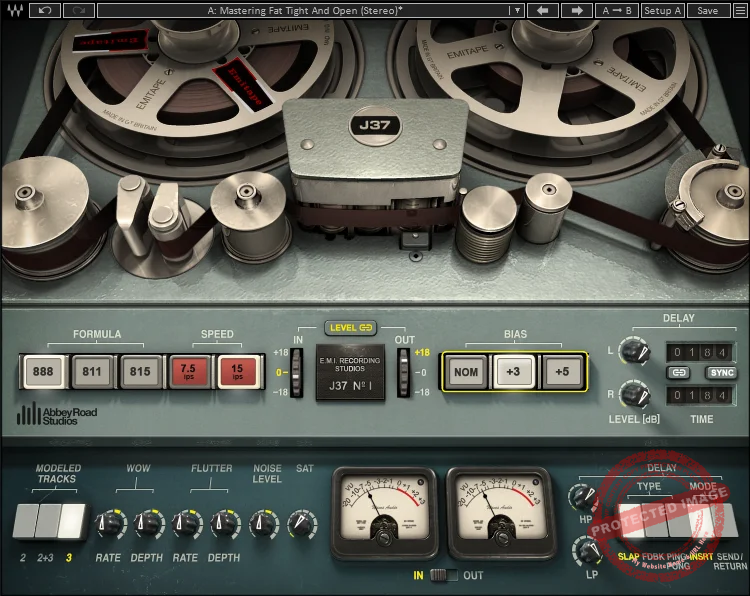
Let’s be honest: we all love the analog warmth and character of the ’60s and ’70s recordings, as we hear in The Beatles or Pink Floyd. If you want that Abbey Road secret sauce in your DAW, Abbey Road J37 Tape is the right plugin for you, as it brings you that authentic analog tape emulation of the Studer J37 tape machine.
The Abbey Road J37 Tape comes with 3 different tape formulas for distinct voices, including 815 for cleaner tones, 811 for midrange presence, and 888 for gritti and lo-fi textures. I like this versatility as these formulas, combined with the selectable playback speeds of 15ips or 7.5ips for different tonal flavors, give you a good amount of choices to experiment with.
When I look at the plugin, I see the Wow & Flutter controls for natural pitch variations as one of the key controls of the unit. The Saturation knob is also a highlight as it adjusts the tone from subtle tape compression to edgy distortion.
What I really loved was the built-in delay section, which really increases the flexibility of the effect with slapback echoes, tempo-synced rhythmic effects, and more. It is a standout feature if you like experimental sound design with a touch of analog flavor.
Some drawbacks include the bulky GUI, even though it looks great with vintage charm and intuitive functions. It is pretty large, especially for smaller screens. Also, I gotta admit I was surprised when I saw the CPU usage of the plugin, as it was really high for a tape emulator. Also, some found the tonal shifts between tape types not as dramatic as they would have liked, but that can be overcome by tweaking other controls.
Despite these drawbacks, I think J37 is a pretty successful tape emulator with the warmth, clarity, and vintage character it adds to the tracks. I often choose it for mix bus processing, adding slapback delays and adding that ’60s flavor to my tracks. For producers who want historical significance and creative flexibility in their workflow, this is a highly valuable tool to have in the collection.
Abbey Road J37 Tape is available in VST3, AAX, and AU (Mac only) formats for macOS Monterey 12 or newer and Windows 10 or later.
6. PuigTec EQs


If you are into music production, you must have heard about the distinctive sound of Jack Joseph Puig’s personal Pultec EQP-1A and MEQ-5 hardware units. There are many vintage EQs trying to hit that unique sound, and PuigTec EQs by Waves is one of the most accurate ones.
The PuigTec EQs collection comes with both mono and stereo versions (which means you get 2 EQs) to take care of different mixing scenarios. The key here is that the unit allows you to boost and cut the same frequency range simultaneously, which is great for creating a resonant shelf and adding presence and clarity to the track. This boost-cut-boost and 3-band design give you great midrange-shaping control, and along with the vintage tonal flavor, you get pretty good results.
One of the things I really like about this plugin is the preset collection created by Jack Joseph Puig himself, who created sounds of many amazing artists such as The Rolling Stones, Black Eyed Peas, No Doubt, John Mayer, and more.
I was surprised at how it could enrich the audio tracks without even tweaking, as the presets were enough to make the tracks shine. It was like whatever the track was missing, the EQ found and fixed it.
I would use this unit to enhance vocals, drums, bass, and acoustic instruments by adding some clarity and presence. But I think it is also a good tool for mastering and mixing bus processing scenarios to glue tracks together with smooth analog-style curves. You can create vintage tones, solve harsh frequencies, or even subtly shape the tonal balance. These EQs thrive at giving you that rich musical character independent from the genre or individual track.
It is a pretty great tool when you get used to its workflow, or you can basically go with the presets, which is also more than okay. It brings an authentic replication of classic Pultec equalizers, delivering vintage analog warmth and character within a modern digital framework.
PuigTec EQs are available in VST3, AAX, and AU (Mac only) formats for macOS Monterey 12 or newer and Windows 10 or later.
7. Vitamin
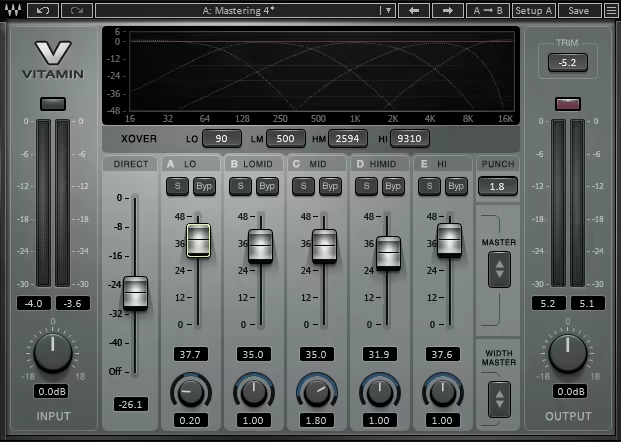
As a multiband sonic enhancer unit, Vitamin combines parallel compression with harmonic enhancement to deliver musical-sounding mixes that can work across a wide range of audio materials. You can add harmonic‑enhancing distortion independently for each of the 5 frequency bands, while the crossover points can be adjusted as you like, giving you the control to finetune the enhancement.
Honestly, I didn’t encounter any other plugin like Vitamin that can take the same task, as I don’t know any plugin that does multiband stereo widening and multiband sonic enhancement simultaneously. Each band in the plugin offers independent gain, crossover, and stereo width controls to enhance high-end sparkle, mid-range presence, and low-end punch.
I love playing with the Punch control, which helps to adjust the transient dynamics for more clarity and less harshness. You can use the solo and bypass functions to listen to the adjustments, while the spectrum curve is there to help you visualize the processed frequencies.
Plus, each band has stereo width controls to keep the low-end mono while expanding mids and highs to create a more immersive and wider-sounding mix.
I recommend going subtle with the unit, as overdoing it can lead to a dirty-sounding mix. Even then, I think it does not really sound bad, and pushing all the controls to the end may lead to muddiness and dirtiness, but some producers might find use for even those realms.
Whether for acoustic instruments, vocal tracks, or dense rhythm loops, Vitamin enhances the sound with harmonic richness and without sacrificing naturality. It is a pretty user-friendly, powerful, and valuable tool for giving the final polish to your tracks.
Vitamin is available in VST3, AAX, and AU (Mac only) formats for macOS Monterey 12 or newer and Windows 10 or later.
8. C6 Multiband Compressor
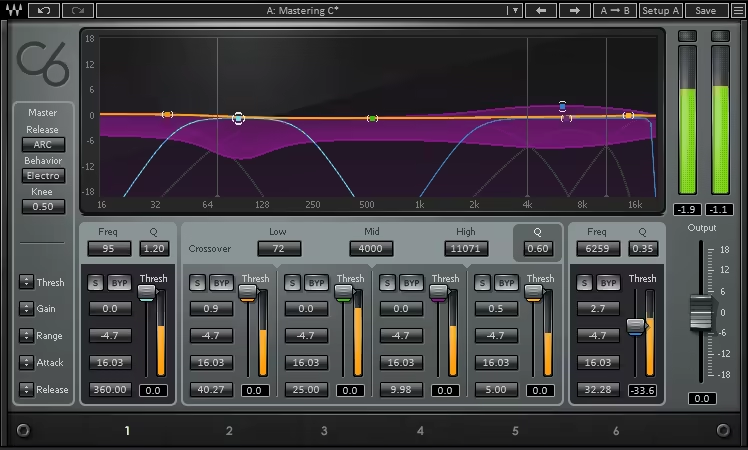
By integrating the dynamic sidechain feature into each of the frequency bands, the C6 Multiband Compressor is one of the best waves mastering plugins as it redefines multiband compression. It gives you precise control over specific frequency ranges without letting you lose the integrity of the overall mix.
The unit comes with 6 adjustable frequency bands with two so-called floating bands, which lets you target the frequencies with issues or emphasize key areas without disturbing the default crossover points. Standard parameters like attack, release, and ratio are accessed easily via a straightforward interface to fine-tune compression for taming harsh vocals, smoothening the bass, or increasing sonic clarity in general.
I think the key feature of the C6 Multiband Compressor is the sidechain input for each frequency band, which is a highly innovative idea that allows you to sculpt dynamic responses for complex tasks like ducking midrange frequencies in a kick drum to allow the bass to come front or create rhythmic effects with reverb.
For me, this unit comes in handy in different scenarios like corrective tasks, including de-essing or dynamic EQ, but I think it can also play a role in creative sound design for enhancing stereo mixes or applying multiband compression to individual tracks. It gives smoothness to drums, character to synths, depth to keyboards, and warmth to master buses.
When you look at the features, you see how versatile the plugin can get as it features 4 different types of powerful dynamics processing, 3 release options with smooth, fast, and automatic control, analog circuitry modeling for warm tones, and over 50 presets that are really good points to start tweaking from.
All in all, I think this is a pretty handy multiband compression unit that can act like an Opto if you choose slower release times or a VCA if you choose faster release times, or it can sit in between with the auto-release feature. I would recommend this one to anyone looking to have control over their compression and need a versatile compressor for different tasks.
C6 Multiband Compressor is available in VST3, AAX, and AU (Mac only) formats for macOS Monterey 12 or newer and Windows 10 or later.

